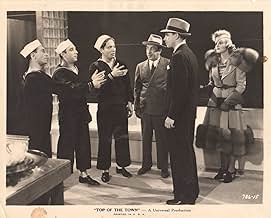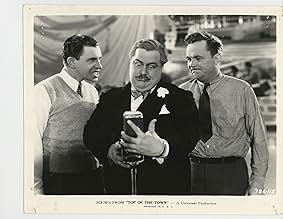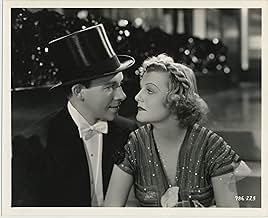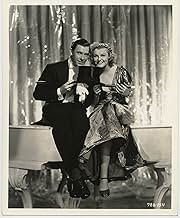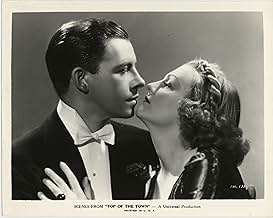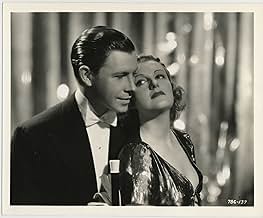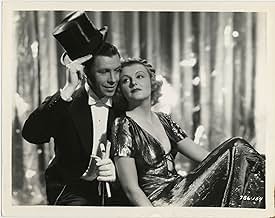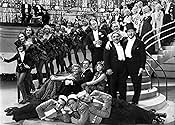Agrega una trama en tu idiomaDiana Borden (Doris Nolan, a bleeding-heart rich-girl, returns from a trip to Russia filled with sympathy for the "little" people of the slums and wants to do "something" artistic and social... Leer todoDiana Borden (Doris Nolan, a bleeding-heart rich-girl, returns from a trip to Russia filled with sympathy for the "little" people of the slums and wants to do "something" artistic and socially significant for them...so she opens up a nightclub atop a 100-story skyscraper. For her... Leer todoDiana Borden (Doris Nolan, a bleeding-heart rich-girl, returns from a trip to Russia filled with sympathy for the "little" people of the slums and wants to do "something" artistic and socially significant for them...so she opens up a nightclub atop a 100-story skyscraper. For her, that means acts such as opera singers, extracts from "Hamlet" and three sailors imitatin... Leer todo
- Dirección
- Guionistas
- Elenco
- Premios
- 3 premios ganados en total
- Beaton
- (as Jack Smart)
- One of The Three Sailors
- (as The Three Sailors)
- One of The Three Sailors
- (as The Three Sailors)
- One of The Three Sailors
- (as The Three Sailors)
Opiniones destacadas
Some of the scenes are just plain bizarre the further you get into the movie.
In 1936 a new administration swept into Universal Pictures determined to remake the studio from top to bottom. "Top of the Town," released the next year, was part of that process and was obviously intended to be the musical to top all musicals. Well, it's not that, not by a long shot -- there are too many ghastly moments. But when "Top of the Town" is good, it's very good indeed, and much of it is hilarious (though sometimes unintentionally).
The plot, such as it is, centers on the opening of a luxury nightclub atop a 100-story skyscraper and the conflict over what kind of floor show to present. Bandleader George Murphy wants hot tunes, belly laughs, great dancing and razzle-dazzle, while the club's owner Doris Nolan (who has just returned from a trip to Russia filled with sympathy for the downtrodden masses) wants something artistic, deep and socially significant. Guess whose version sends the audience away in droves, and guess whose version brings them back singing and dancing.
But the plot is just an excuse to string together a wild variety of musical-comedy specialty numbers. "Top of the Town" is like an old-time vaudeville show, with some good comedy (like the Three Sailors, who combine their bodies in bizarre ways to "impersonate" camels and giraffes), some bad comedy (Hugh Herbert, a little of whom...), a lot of terrific songs by Jimmy McHugh and Harold Adamson (including two big hits, "There Are No Two Ways About It" and "Where Are You?", the latter of which became a standard), some great dancing by Murphy and 13-year-old Peggy Ryan (in her first movie), and absolutely eye-popping Art Deco sets by legendary Broadway designer John Harkrider.
And above all, the last half-hour, which begins with the (intentionally) hilarious disaster of the Doris Nolan character's "entertainment" program and continues through George Murphy and the gang swinging to the rescue, is just about the most spectacular, cast-of-thousands-style toe-tapping production number in Hollywood history (the song, an infectious one, is called "Jamboree.") It's so irresistible that it easily erases any misgivings you might have had about the first 60 minutes.
The performers, like the film as a whole, are something of a mixed bag. George Murphy was clearly going places (though no one could have predicted the U.S. Senate), as was little Peggy Ryan (she became a popular star in the 1940s in a series of B-musicals with Donald O'Connor; they were Universal's answer to Mickey Rooney and Judy Garland).
A little more problematic are the two female vocalists. Ella Logan has pep and obvious talent, and she really shines in "There Are No Two Ways About It," but her enthusiasm becomes a bit obnoxious at times. Gertrude Niesen was, frankly, a little too odd-looking to make it in movies -- stocky and rather hard-faced, with an unflattering Prince Valiant hair-do. Still, there are times when (thanks to Joseph Valentine's soft-focus photography) she suggests a younger, 1930s version of Bette Midler. And she does a rendition of "Where Are You?" ("Where are you?/Where have you gone without me?/I thought you cared about me...") that is absolutely unforgettable. Since Niesen (like Logan) would become a major Broadway star in the 1940s, I suspect that this is a case where a performer's film career suffered not from a lack of talent but simply because the camera didn't like her.
It's a real hodge-podge and definitely a mixed bag, but "Top of the Town," whatever its faults, is at least never boring. When it's good it's terrific, and even when it's bad it's entertaining. As I said before, you'll probably never get the chance to see it. But if you do, and if you enjoy 1930s musicals, you won't be sorry you caught up with this one.
The film opens with an innovative and enjoyable title sequence, which introduces most of the performers (but not Joyce Compton, who has a larger role than several actors shown here). Then the movie plunges into deepest cliché, with a Manhattan street scene accompanied by the hackneyed hustle-bustle music that accompanies the opening shot in so many big-city movies. (Played on a xylophone, to deepen the cliché.) But now Doris Nolan arrives, in a Venus-in-Furs rig that instantly got my undivided attention: in furs and kid-leather gauntlets, she strides across the set wielding a prop that can't decide whether it's a walking-stick or a riding-crop.
Nolan plays Diana Borden, a dilettante heiress who has just visited Russia and who addresses strangers as 'comrades'. She wants to build the biggest poshest nightclub of all time (I guess she got that idea in communist Russia), and she expects her four wealthy uncles to foot the bill.
The cast includes several Hollywood stalwarts whom I don't usually associate with Universal. Obscure actor Ray Mayer gives a very impressive performance as the assistant of bandleader George Murphy. Ella Logan was an important theatre performer (she starred on Broadway in 'Finian's Rainbow') who made very few films, so I'm glad to see her here.
This movie is art-directed to a fare-thee-well. The sets are extremely impressive, but too distracting. The overkill is obvious when Ella Logan steps out of an Art Deco taxi cab. This has got to be the only New York City taxi that doesn't list its rates on the doors; apparently listing the fares would spoil the Art Deco design.
En route to this movie's climax are some astonishing musical numbers. Hugh Herbert warbles 'Fireman, Save My Child' while chorines in pyjamas trapeze overhead. Juvenile tap-dancer Peggy Ryan does a virtuoso imitation of Eleanor Powell, although she doesn't do Powell's signature move (the backbend over her shoulder, touching the floor with her hand). Recurring throughout the film are a speciality act cried the Three Sailors: a trio of gobs, smacking each other and intertwining their bodies to impersonate camels and other unexpected things. The Three Sailors seem to be a cross between the Stooges and the Ritz Brothers, but with more physical discipline than those acts. I was very impressed by a music-hall turn in which the sailors tap-dance while skipping rope.
Diana Borden has no difficulty raising the money to finance her extravaganza, but she has trouble finding performers. (In my experience, it's always just the other way round.) She manages to 'meet cute' -- not once, but twice -- with bandleader Ted Lane (George Murphy, better than usual). He wants to mount a traditional musical revue, but spoilt heiress Diana wants to do something 'meaningful'. She sacks all of Murphy's singers and dancers, but they show up at the nightclub anyway to work as waiters and cigarette girls. (Aren't there union rules against this?)
SPOILERS COMING. The climax takes place on one of the most astonishing film sets I've ever seen: a four-tier nightclub, filled with hundreds of dress extras. This is no miniature, no matte shot. The camera crane dollies from one level to the next, in a 360-degree pan that's even more impressive than the opening sequence in 'Touch of Evil'.
But what's all this dazzlement for? It all builds to a floor show that's *deliberately* bad, with Russian peasants toiling in the salt mines while blackface minstrels pull faces. Mischa Auer, costumed as Hamlet (and looking amazingly like Conrad Veidt) recites the 'To be or not to be' soliloquy with an uncredited actor's dubbed voice. The nightclubbers are getting nasty. George Murphy signals the wait-staff; they swing into a production number that's *meant* to be good (but isn't, very much) and all ends happily. This is one of those movies in which the leading lady learns she that needs a man to do her thinking for her, and this is supposed to be a happy ending.
'Top of the Town' is one of the most unusual movies I've ever seen, but that's not entirely favourable. I'll rate this movie 6 out of 10.
¿Sabías que…?
- TriviaThis is the first Universal film to open with the "sparkling globe" logo (used through 1946), accompanied by the musical fanfare entitled "New Universal Signature" composed by Jimmy McHugh.
- Citas
Augustus Borden: We've never been firm enough with her, that's the trouble.
Henry Borden: We're going to be from now on.
Augustus Borden: She's never been the same since she visited Russia.
Edwin Borden: The way I heard it, Russia hasn't been the same.
- Créditos curiososNo cast names are shown or presented until after all the opening credits are listed. Then, the cast members are introduced singing lines from the title song. Then in the first few scenes, the supporting players are presented delivering their dialogue in rhyme.
- ConexionesReferenced in Man of a Thousand Themes: Frank Skinner at Universal (2023)
Selecciones populares
Detalles
- Fecha de lanzamiento
- País de origen
- Idioma
- También se conoce como
- Čarobne nožice
- Locaciones de filmación
- Productora
- Ver más créditos de la compañía en IMDbPro
- Tiempo de ejecución1 hora 26 minutos
- Color
- Relación de aspecto
- 1.37 : 1
Contribuir a esta página


